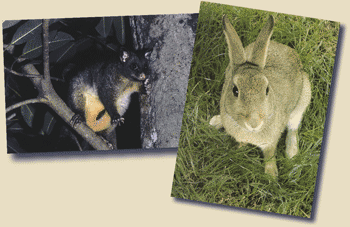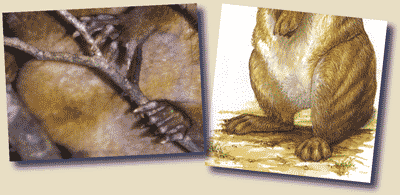| Approach: One
to one |
Level:
Year 4
and year 8 |
|
| Focus:
Habitats
and adaptation
|
| Resources:
4 pictures
|
 |
1.8Mb |
|
|
| Questions/instructions:
In
this activity you will be looking at pictures of two animals and
thinking about their similarities and differences.
Show pictures 1 & 2 (possum & rabbit).
This is a picture of a possum and this is a picture of a rabbit.
I’m going to ask you some questions about these animals so
have a careful look at both pictures.
Allow time.
Now think about where each animal lives and
how it lives. |
 |
|
|
%
responses
2003 ('99) |
| y4
|
y8 |
1.
Tell me about where the possum lives.
Where does it make its home?
|
bush/forest/trees
|
98
(98) |
99
(99) |
2.
Tell me about where the rabbit lives.
Where does it make its home?
|
Usual
habitat: |
|
|
fields/hills/grass/paddocks
|
41
(43) |
47
(35) |
underground
in holes/burrows/warrens |
79
(76) |
86
(89) |
|
Give student picture 1: possum. |
|
|
3.
Let’s look at the possum. What is special about this animal that
helps it survive and live in its natural surroundings?
Prompt: How does that help it to survive?
|
Possible
features:
[claws for climbing/eating; fur for warmth or camouflage;
tail for balance; whiskers for sense of space; large eyes to see in
dark; sharp teeth for eating] |
|
|
2
or more relevant features plus good justification |
18
(20) |
38
(44) |
1
relevant feature plus good justification |
23
(30) |
25
(17) |
2
or more relevant features but no justification |
5 (8) |
7
(9) |
1
feature, not justified |
11
(7) |
9
(13) |
|
Give student picture 2: rabbit. |
|
|
4.
Let’s look at the rabbit.
What is special about this animal that helps it survive and live in its
natural surroundings?
Prompt: How does that help it to survive?
|
Possible
features:
[large feet and claws for digging burrows; large
back legs for running fast; large ears to hear danger easily, fur for
warmth and camouflage; large eyes to see in dark; big sharp front teeth
for cutting/eating grass and leaves] |
|
|
2
or more relevant features plus good justification |
20
(26) |
38
(42) |
1
relevant feature plus good justification |
22
(22) |
19
(21) |
2
or more relevant features but no justification |
7 (9) |
9
(9) |
1
feature, not justified |
7
(9) |
9
(5) |
| Show
pictures 3 & 4 (possum feet & rabbit feet). |
 |
|
|
|
5.
This time look carefully at the animals’ feet.
Why do you think possum and rabbit feet are different? |
|
|
| 6.
What is special about a possum’s feet that helps it live and survive? |
|
|
| 7.
What is special about a rabbit’s feet that helps it live and survive? |
|
|
| Based
on all three questions: |
|
|
| |
explains
that feet have different functions
(e.g. climbing for possum, digging for rabbit) |
58
(55) |
81
(73) |
Possums’
feet:
[sharp claws for feeding, climbing, defense]
|
mentions
claws and 2–3 functions |
12
(15) |
23
(22) |
mentions
claws and 1 function |
43
(37) |
51 (49) |
mentions
claws but no function |
24
(24) |
18
(18) |
Rabbits’
feet:
[large back legs for fast travel, defense and burrowing;
front feet for holding food, defense and burrowing]
|
1
or more features with good explanation |
33
(31) |
52
(48) |
| 1
or more features without useful explanation |
30
(36) |
30
(31) |
| |
Total
Score:
|
17–20
|
8
(8) |
23
(24) |
13–16
|
22
(21) |
33
(27) |
9–12
|
26
(31) |
26
(28) |
5–8
|
31
(31) |
15
(20) |
0–4
|
13
(9) |
3
(1) |
Commentary
Students showed quite good knowledge and analytical skills about the habitats
and adaptation of possums and rabbits. About 25 percent more year 8 than
year 4 students scored above 12. Overall, there was no discernible change
between 1999 and 2003. |